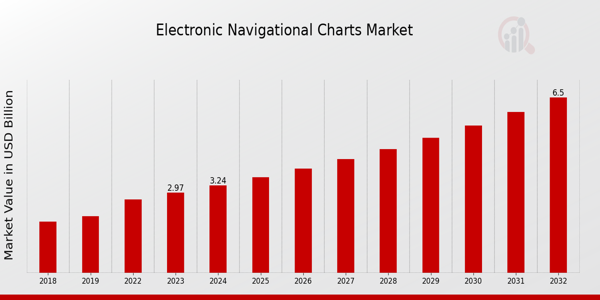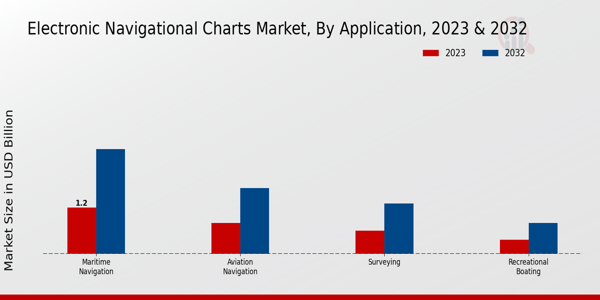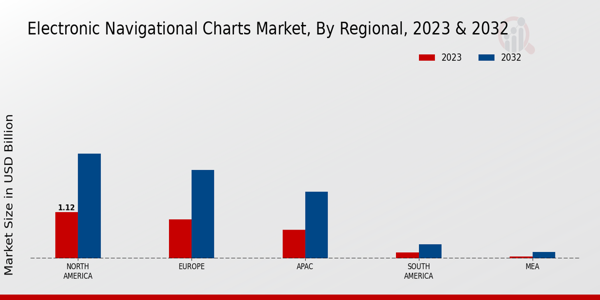Electronic Navigational Charts Market Overview
As per MRFR analysis, the Electronic Navigational Charts Market Size was estimated at 3.54 (USD Billion) in 2024. The Electronic Navigational Charts Market Industry is expected to grow from 3.87 (USD Billion) in 2025 to 8.45 (USD Billion) till 2034, at a CAGR (growth rate) is expected to be around 9.82% during the forecast period (2025 - 2034).
Key Electronic Navigational Charts Market Trends Highlighted
The growing importance of safe navigation and the expansion of maritime trade are driving the significant growth of the market for electronic navigational charts. The performance and efficiency of electronic charts have improved due to the incorporation of technology into navigation systems, increasing their attractiveness to different shipping industry stakeholders. Demand in the market is also being driven by strict laws requiring the use of electronic navigational aids for safety. The development and improvement of electronic navigational charts is also greatly aided by advancements in satellite technology, which supply accurate and up-to-date data that is crucial for contemporary navigation.
The Electronic Navigational Charts Market is experiencing notable growth driven by increasing maritime trade and the rising emphasis on safe navigation. The integration of technology in navigation systems has enhanced the performance and efficiency of electronic charts, making them more appealing to various stakeholders in the shipping industry.
Furthermore, stringent regulations mandating the use of electronic navigational aids for safety purposes are propelling market demand. Innovations in satellite technology also contribute significantly to the development and enhancement of electronic navigational charts, providing precise and real-time data essential for modern navigation.
Opportunities in this market are becoming more apparent as the demand for accurate navigational data rises. The growing adoption of autonomous ships presents a unique opportunity, as these vessels rely heavily on electronic charts for operational safety and efficiency.
Additionally, emerging markets are starting to invest in modern maritime infrastructure, further expanding the potential for electronic navigational chart adoption. Collaborations between technology providers and maritime companies can lead to the development of more sophisticated navigation solutions, improving overall maritime safety and efficiency.
Recently, trends such as the shift toward digital solutions and the increasing focus on eco-friendly navigation practices have gained traction.
The advent of cloud-based technologies allows for real-time updates of electronic charts, providing users with dynamic and accurate information.
The growing interest in integrating artificial intelligence into navigational systems is also transforming how electronic charts are developed and utilized. As the industry evolves, the emphasis on enhancing user experience and ensuring compliance with international maritime regulations continues to shape the future of the electronic navigational charts market.
Fig 1: Electronic Navigational Charts Market Overview

Source: Primary Research, Secondary Research, MRFR Database and Analyst Review
Electronic Navigational Charts Market Drivers
Increasing Adoption of Advanced Marine Technologies
The adoption of advanced marine technologies is one of the most prominent drivers of growth in the Electronic Navigational Charts Market IndustryMarket. As marine operations continue to evolve, the integration of high-tech navigation tools is becoming essential for achieving precision and safety during voyages.
Electronic Navigational Charts (ENCs) have revolutionized marine navigation, offering real-time data and enhanced situational awareness to ship operators.
As trade grows and the maritime industry expands, the demand for reliable and efficient navigation systems will surge.
This shift is primarily driven by the need for improved operational efficiency and the growing emphasis on maritime safety regulations.
Modern vessels are now equipped with sophisticated bridge technologies that require up-to-date navigational systems, leading to a greater preference for ENCs over traditional paper maps. The continuous advancements in satellite systems and the development of next-generation navigation software further accelerate the need for Electronic Navigational Charts.
As the new decade unfolds, it is anticipated that these technologies will permeate the maritime sector, significantly increasing the adoption rate of Electronic Navigational Charts.
Furthermore, the necessity for precise navigational data, especially in crowded or hazardous waters, will enhance the importance of ENCs in both commercial and recreational boating. This trend reflects a broader commitment to ensuring marine safety and efficiency, marking a significant turn towards reliance on contemporary navigational aids.
Growing Focus on Maritime Safety and Compliance
The growing focus on maritime safety and compliance is driving significant growth in the Electronic Navigational Charts Market IndustryMarket. Governments and regulatory organizations around the world have implemented stringent maritime safety regulations that mandate the use of electronic systems for navigation.
This regulatory landscape encourages vessel operators to shift from traditional navigation methods to sophisticated Electronic Navigational Charts, which provide safer, more efficient navigation capabilities.
Compliance with international conventions and local maritime laws is fueling the demand for advanced navigational tools that can help operators maintain safety standards and avoid penalties.
Enhanced safety features and the ability to receive real-time updates on navigational hazards make ENCs indispensable for maritime operators aiming to comply with safety regulations.
Rising Demand for Efficient Supply Chain Logistics
The rising demand for efficient supply chain logistics is another critical driver boosting the Electronic Navigational Charts Market IndustryMarket. With the expansion of trade, businesses are increasingly looking for ways to optimize their logistics and reduce operational costs.
Efficient navigation solutions provided by Electronic Navigational Charts play a vital role in streamlining shipping routes, minimizing transit times, and reducing fuel consumption.
This need for efficiency not only supports the sustainability goals of shipping companies but also enhances overall profitability by providing timely deliveries and improved service levels.
Electronic Navigational Charts Market Segment Insights
Electronic Navigational Charts Market Application Insights
The Electronic Navigational Charts Market is notably structured around various applications, which play a pivotal role in the overall functionality and development of navigation systems.
The majority of the market was driven by Maritime Navigation, valued at 1.2 USD Billion, which continued to be a crucial segment as it catered to the increasing demand for safe and efficient navigation in shipping and logistics.
Maritime applications not only dominated the segment but also represented a significant portion of the total market, integrating advanced technologies for vessel traffic management and safety, driving its prominence and continued investment.
Following closely was the Aviation Navigation segment, valued at 0.8 USD Billion in 2023. Aviation Navigation was critical for ensuring air traffic safety and efficiency, highlighting the necessity for reliable navigational charts in an era where the industry faces growing air traffic demands.
Moreover, Surveying held a substantial value at 0.6 USD Billion, as it emphasizes the importance of precision in mapping and environmental monitoring, which is essential for various industrial and governmental applications. Surveying was significant as it supported foundational data gathering, which informed multiple sectors, from construction to environmental conservation.
Additionally, Recreational Boating, with a valuation of 0.37 USD Billion in 2023, represented a niche yet important market segment, indicating that consumer interest in leisure activities presented unique opportunities for the adoption of electronic navigational charts.
As recreational boating continues to gain popularity, there is potential for introducing innovative navigation solutions that cater to the specific needs of leisure boaters, thereby enhancing safety and user experience on the water.
The combined insights into these application areas demonstrate a diverse landscape, with the Electronic Navigational Charts Market showing promising statistics and segmentation that reflect a growing dependency on navigational technology across various sectors.
The future market growth is poised to pivot on the advancements in technology, regulatory frameworks supporting digital navigation, and a rising need for safety and efficiency in both commercial and recreational navigation.
Overall, the exploration of these applications within the Electronic Navigational Charts Market reveals a rich tapestry of opportunities and challenges that will shape the industry's trajectory in the coming years.
Fig 2: Electronic Navigational Charts Market Insights

Source: Primary Research, Secondary Research, MRFR Database and Analyst Review
Electronic Navigational Charts Market Technology Insights
The market growth is driven by factors such as the rising demand for precise navigation and safety in maritime operations. The segmentation of this market includes various technologies, prominently featuring Raster Charts, Vector Charts, and 3D Charts.
Raster Charts hold a substantial share due to their simplicity and compatibility with various devices, making them widely adopted by mariners.
Vector Charts are gaining traction for their ability to provide detailed information and interoperability with advanced navigation systems, thus enhancing operational safety.
Furthermore, 3D Charts are becoming increasingly important as they offer a realistic depiction of navigational routes, which improves situational awareness for users. This blend of traditional and innovative charting technologies underpins the evolving Landscape of the Electronic Navigational Charts Market data, showcasing its critical role in enhancing maritime navigation and safety.
Electronic Navigational Charts Market Deployment Mode Insights
The market is projected to grow significantly by 2032, reflecting a growing reliance on advanced navigational technologies. Within this segment, the market is prominently influenced by two primary modes: On-Premises and Cloud-Based solutions.
On-premises deployment caters to organizations seeking security and control over their data, thus holding a notable position in the market. Meanwhile, Cloud-Based solutions are gaining traction due to their flexibility, scalability, and cost-effectiveness, making them attractive for both small and large enterprises.
As these deployment models evolve, the demand for Electronic Navigational Charts is expected to increase, driven by advancements in technology, rising awareness of efficient navigation systems, and greater adoption in various marine applications.
In addition, the increasing need for real-time data updates and improved operational efficiency presents opportunities for further market growth within these deployment modes.
As organizations continue to invest in modern navigational tools that leverage data accessibility and analysis, the landscape of the Electronic Navigational Charts Market is likely to become more dynamic and competitive, reflecting changing customer preferences and technological advancements.
Overall, the integration of these deployment modes plays a crucial role in enhancing navigational accuracy and safety across the marine sector.
Electronic Navigational Charts Market End Use Industry Insights
The Electronic Navigational Charts Market showcases a diverse end-use industry landscape, primarily encompassing the Marine Industry, Aviation Industry, and Government and Defense sectors.
These industries significantly contribute to the market growth, reflecting the rising demand for precision and safety in navigation. The Marine Industry plays a crucial role, as electronic navigational charts are essential for maritime operations, ensuring efficient and safe voyages.
Similarly, the Aviation Industry benefits from accurate navigational information, promoting better air traffic management and operational safety.
The Government and Defense segment is equally vital, utilizing electronic charts for strategic operations, border monitoring, and national security initiatives. The market is expected to present various opportunities, driven by advancements in technology and increasing adoption of electronic navigational solutions.
However, challenges such as regulatory compliance and the need for integration with legacy systems may impact the pace of market growth.
Overall, the Electronic Navigational Charts Market is positioned for robust expansion, demonstrating significant potential across these end-use industries.
Electronic Navigational Charts Market Regional Insights
The Electronic Navigational Charts Market is significantly impacted by its regional segmentation, reflecting diverse valuation dynamics.
In 2023, North America led the market with a value of 1.12 USD Billion, holding a majority share due to advanced maritime technology and robust infrastructure. Europe followed closely with a valuation of 0.95 USD Billion, benefiting from stringent regulations promoting navigational safety.
The APAC region held a value of 0.70 USD Billion, displaying significant growth potential as shipping activities surge.
South America, though smaller, showed promise with a valuation of 0.15 USD Billion, driven by increasing investments in maritime logistics.
Furthermore, the MEA region, with a valuation of 0.05 USD Billion, presented opportunities for growth, primarily influenced by evolving industries.
The regional statistics demonstrated how distinct factors like technological advancements, regulatory frameworks, and economic activities play pivotal roles in shaping the Electronic Navigational Charts Market revenue, revealing opportunities for strategic investments and market growth across these diverse territories.
Fig 3: Electronic Navigational Charts Market Regional Insights

Source: Primary Research, Secondary Research, MRFR Database and Analyst Review
Electronic Navigational Charts Market Key Players and Competitive Insights
The Electronic Navigational Charts Market is characterized by intense competition among a range of players who seek to capture significant shares and enhance their technological prowess. As digital navigation becomes paramount in marine and aerial sectors, companies are rapidly innovating their product offerings to accommodate evolving requirements in accuracy, accessibility, and usability.
The market features established firms and emerging challengers vying for dominance, with strategic partnerships and technological advancements playing crucial roles in shaping competitive dynamics.
Increased adoption of electronic navigational systems across various applications, including shipping, aviation, and recreational boating, has heightened the demand for comprehensive navigational solutions, further intensifying competition.
Regulatory compliance and the pursuit of sustainable practices are also influencing how companies position themselves in this market.
Fugro has established a robust presence in the Electronic Navigational Charts Market through its commitment to leveraging cutting-edge technology and data analytics.
The company has developed an extensive portfolio of electronic charts and navigational systems that cater to a wide range of maritime operations, providing reliable and precise data. Fugro's strength lies in its established reputation in geospatial services, which enhances its credibility and enables it to offer superior navigational solutions.
The company is known for its emphasis on research and development, allowing it to innovate consistently and meet the changing demands of clients. Furthermore, strong relationships with regulatory bodies and industry stakeholders for compliance and standards in chart production reinforce Fugro's market position, making it a formidable competitor.
Jeppesen, a key player in the Electronic Navigational Charts Market, has built a strong foundation on delivering cutting-edge navigational solutions tailored for the aviation and maritime industries.
The company specializes in providing high-quality digital charts and electronic flight bag solutions, which are indispensable for flight planning and safe navigation. Jeppesen's strength lies in its long history of expertise in navigation and its commitment to technological advancements that enhance situational awareness for users.
With an expansive user base and a reputation for reliability and accuracy, Jeppesen effectively meets the demands of modern maritime and aviation sectors.
The company continues to invest in research and innovation, ensuring that its offerings remain competitive while focusing on user experience and compliance with international regulations, further solidifying its position in the electronic navigational charts market.
Key Companies in the Electronic Navigational Charts Market Include
-
Fugro
-
Jeppesen
-
MarineTraffic
-
ChartWorld
-
Teledyne Technologies
-
The British Admiralty
-
ExactEarth
-
MyOcean
-
Inmarsat
-
CMAP
-
Raytheon Technologies
-
ESRI
-
DigitalGlobe
-
Navionics
-
Kongsberg Gruppen
Electronic Navigational Charts Market IndustryMarket Developments
The Electronic Navigational Charts Market has recently experienced notable developments with key players like Fugro, Jeppesen, and MarineTraffic reporting advancements in their charting technologies.
ChartWorld has introduced improved services for digital navigation, enhancing reliability for maritime operators. Teledyne Technologies and The British Admiralty have collaborated on integrated solutions aiming to streamline navigation processes, responding to increasing demands for real-time data accuracy.
ExactEarth and MyOcean are focusing on satellite-based services that aim to increase maritime situational awareness and safety. In terms of mergers and acquisitions, recent activity in the market has been marked by efforts from Inmarsat to expand its data solutions through strategic partnerships.
The market valuation for companies like Raytheon Technologies and ESRI continues to grow as demand for innovative navigation solutions rises alongside ongoing investments in technology.
DigitalGlobe and Navionics are aligning their product offerings to better cater to the evolving needs of marine navigation, indicating a shift towards user-centric approaches.
The continuous drive for safety and efficiency in maritime operations is further propelling advancements in electronic navigational chart technologies.
Electronic Navigational Charts Market Segmentation Insights
Electronic Navigational Charts Market Application Outlook
- Maritime Navigation
- Aviation Navigation
- Surveying
- Recreational Boating
Electronic Navigational Charts Market Technology Outlook
- Raster Charts
- Vector Charts
- 3D Charts
Electronic Navigational Charts Market Deployment Mode Outlook
Electronic Navigational Charts Market End Use Industry Outlook
- Marine Industry
- Aviation Industry
- Government and Defense
Electronic Navigational Charts Market Regional Outlook
- North America
- Europe
- South America
- Asia Pacific
- Middle East and Africa
| Report Attribute/Metric |
Details |
|
Market Size 2024
|
3.54 (USD Billion)
|
|
Market Size 2025
|
3.87 (USD Billion)
|
|
Market Size 2034
|
8.45 (USD Billion)
|
|
Compound Annual Growth Rate (CAGR)
|
9.82% (2025 - 2034)
|
|
Report Coverage
|
Revenue Forecast, Competitive Landscape, Growth Factors, and Trends
|
|
Base Year
|
2024
|
|
Market Forecast Period
|
2025 - 2034
|
|
Historical Data
|
2019 - 2023
|
| Market Forecast Units |
USD Billion |
| Key Companies Profiled |
Fugro, Jeppesen, MarineTraffic, ChartWorld, Teledyne Technologies, The British Admiralty, ExactEarth, MyOcean, Inmarsat, CMAP, Raytheon Technologies, ESRI, DigitalGlobe, Navionics, Kongsberg Gruppen |
| Segments Covered |
Application, Technology, Deployment Mode, End Use Industry, Regional |
| Key Market Opportunities |
Increased maritime safety regulations, Technological advancements in charting, Rise in autonomous vessels, Growing demand for environmental sustainability, Expansion of shipping routes |
| Key Market Dynamics |
Growing maritime trade, Technological advancements, Regulatory compliance requirements, Rising demand for safety, Increasing adoption of automation |
| Countries Covered |
North America, Europe, APAC, South America, MEA |
Frequently Asked Questions (FAQ) :
The market is expected to be valued at 8.45 USD Billion in 2034.
The expected CAGR for the market is 9.08% from 2025 to 2034.
North America is projected to hold the largest market share with a value of 2.54 USD Billion in 2032.
The market size for Maritime Navigation is expected to reach 2.7 USD Billion in 2032.
Fugro is recognized as one of the major players in the market.
The projected market size for Aviation Navigation is 1.7 USD Billion in 2032.
The market value for the APAC region is anticipated to be 1.62 USD Billion in 2032.
The Recreational Boating segment is expected to grow to 0.8 USD Billion by 2032.
The market size for Surveying applications is projected to reach 1.3 USD Billion in 2032.
Europe's market size is expected to be valued at 2.14 USD Billion in 2032.

















